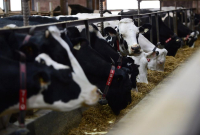Support strong Canadian climate journalism for 2025
Supply management: economists love to hate it, and Canadian farmers are loathe to give it up.
The politically explosive issue emerged yet again Monday as a flashpoint in increasingly heated NAFTA renegotiation talks after the United States asked for an end to the system within the next decade.
So what, exactly is supply management, and why does it stir up so much controversy?
The debate has been going on since the federal government created the system in the early 1970s in response to wide swings in prices and interprovincial trade disputes as technology and other developments disrupted the agricultural markets.
The complicated system sets prices and protects Canadian farmers from competition, creating stability for dairy, egg, chicken and turkey producers. But it is seen as a symbol of government overreach and distortion of the market by those opposed.
Because the system blocks out foreign production from the Canadian market, it is a thorn in the side of trade negotiators as other countries look for freer access to Canada's food markets, while Canadian politicians have shied away from any drastic changes.
The federal and provincial governments use a few ways to control the market.
They keep out foreign competition with high tariffs on imports, which vary by product but run as high as 300 per cent for butter.
To avoid oversupply, provincial boards regulate how much farmers are allowed to produce.
For example, any farmer, except very small producers, that wants to produce eggs, milk, or poultry needs to secure a government "quota," or production allotment. Much like the medallion system that regulates the number of taxi drivers, quotas mean a farmer has the right to produce a certain amount of the product.
Any new farmer has to buy in, and the rights don't come cheap. The prices vary significantly by category and by province, some of which have capped how high the quota price can go.
In 2015, the right to produce a kilogram of butterfat a day — the standard measurement for dairy quotas — sold for $42,500 in British Columbia, but for $23,000 in New Brunswick. Overall, the government says the value of all the supply management quotas issued stood at about $35 billion last year.
Finally, with both foreign and domestic competition limited by the system, the government boards need to decide how much farmers will be paid for their production, since standard market forces that are supposed to set prices aren't at work.
The government sets a minimum price that processors have to pay the farmers, or a "price floor." Critics have argued that floor is artificially high, meaning dairy and other products cost more for Canadian consumers that they might otherwise.
To help determine the price, provincial boards canvas producers to figure out the costs of production and then add a margin of profit to determine how much they're guaranteed to be paid, explained Alfons Weersink, a professor of food and agriculture economics at the University of Guelph.
"The system provides a stable return, and a decent return. And that's the hallmarks of the system," said Weersink. "It's not subject to volatility of other agricultural sectors, which are inherently variable; ups and downs in prices constantly."
But that artificial, government-controlled price stability goes against the basic tenants of free-market thinking, according to economists like Herbert Grubel.
The senior fellow at the Fraser Institute, and professor emeritus of economics at Simon Fraser University, says the system inflates prices, with several studies showing the average household pays hundreds of dollars more because of it, and that it would be better for the market to set prices and adjust for risks.
"The free market adjusts the returns that people get from certain activities by taking account of the amount of risk they take," said Grubel.
He believes the quota system adds significant costs to farmers (and therefore consumers) because they have to buy the right to produce, and take on significant debt to do so.
The industry, however, disputes that there would be any savings from dismantling the system, and that other countries provide more indirect subsidies to their agriculture industries.
The issue came up in Trans-Pacific Partnership talks, while U.S. negotiators have demanded an end to the system as part of ongoing NAFTA negotiations.
Canada did make concessions in the recently enacted Comprehensive Economic and Trade Agreement with the European Union, allowing 16,000 tonnes of duty-free cheese plus another 1,700 tonnes for use in food processing, while leaving the system as a whole largely unchanged.
There have been various proposals on how to dismantle the system, either by adding a surcharge to products to compensate farmers for their quota investments, or to gradually keep increasing the number of quotas allotted, but it won't be a simple affair to dismantle such an entrenched program.





Comments